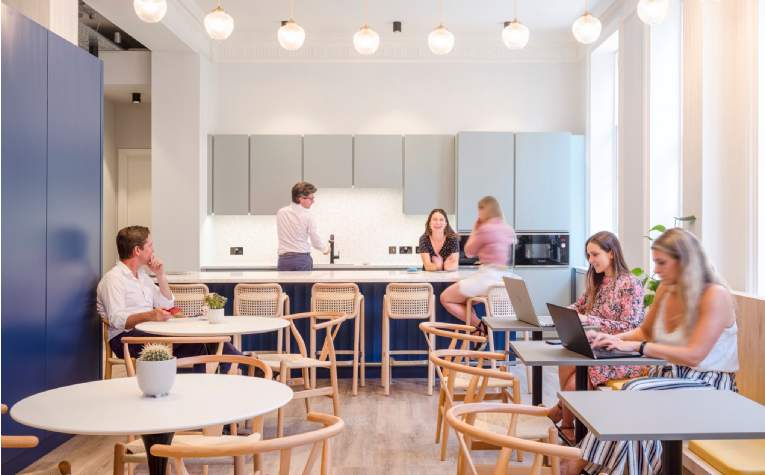Katrina Kostic Samen, newly appointed Vice Chair, Head of Savills Workplace Studio | North America, brings more than three decades of commercial development, occupier strategy, and design experience to her new leadership role at the firm. Throughout her career, she has continually pushed boundaries and made the human experience, in spaces and in the design process, fundamental to her practice. “Be creative, add value, have fun” is a mantra that guides Katrina and her team on extraordinary design and adaptive reuse projects around the world. In our latest “Three Questions” feature spotlight, we speak to Katrina about her focus on the best interests of the occupier and their business, her “inside-out” approach to tenant advisory, and her passion for diversity in the workplace and supporting the next generation of real estate, architecture, and interior design specialists.
Q. Your mantra, “Be creative, add value, have fun,” has been at the heart of your practice and integral to your reputation amongst clients, colleagues, and the industry at-large. How do you apply this mantra to your work, in the process itself and the finished product?
KKS: When I set up my business, KKS Strategy, twenty years ago, I set out a vision which would include who I was as a person, and also my goals, hopes, and parameters. Be Creative speaks to who I am at the heart: an innovator. Add Value speaks to working hard for a reason: to solve problems for our clients and push them beyond. Have Fun is a key component for everyone in life: to remember that we all must love what we do every day. And the fourth pillar, which I share with clients at the pitch, is to make money! If these qualities are not represented in the projects that we go after, then I would not take on the remit.
Q. What do you believe will be the greatest opportunity in your new role as Head of Workplace Design and Strategy?
KKS: The greatest opportunity I have is to lead our Savills Workplace Studio in North America, with wonderful and talented people, one which is renowned for innovative strategic thinking, a reputation for high quality work, an inside-out ethos to always putting the occupier first, and an exciting and dynamic collaborative approach with my fellow colleagues and clients. We aim to be a collaborative group in order to truly harness the potential of our integrated platform across North America.
Q. What trends in workplace design and strategy were you pushing forward prior to Covid? In what ways have those trends remained relevant, grown in importance/priority for clients, or disappeared altogether from the landscape? And what is your first piece of advice to an executive who is thinking about their company’s current and future workplace design and strategy?
KKS: Workplace trends have certainly been evolving over the last 15 years, and unfortunately the sad reality of Covid pushed all our thinking straight to the fore. Let me show you that trajectory. In 2007, I predicted we would only need a horizontal worksurface and form of technology (i.e. death to the cubicle!). In 2012 the notion that tenants had a right to re-design the building to suit a larger capacity and shared amenities. Our 2014 survey found that the greatest needs of our young 14-18 year olds only wanted natural light, outdoor space, and food. In 2015 the notion of a third space at home. In 2016, we first wrote about neurodiversity. In 2018 a new British Council for Offices technical guide to focus on the Occupier. In 2019, that the S in ESG was as important to understand the social values of an organization. And, most recently, in 2021-22 two papers devoted to the need to transform and transition to a new way.
My advice to an executive who is thinking about their company’s current and future workplace design and strategy is this: This is the time to be brave. Don’t sit back and wait for the first to break ranks – go for the change now. Evaluate what your staff are telling you, take advice from Workplace professionals who have a global view on trends, openly discuss hopes and fears and post-occupancy real-life feedback, and take stock of their basic needs. Then layer on the wants and desires. Start bottom-up, not top-down, in assessing the brief.
And a bonus question for our readers!
Q. As President of the British Council for Offices (the only woman elected in three decades), you proudly increased women membership and shifted demographics for a critical mass of new thinking. In the London KKS Studio, there are over a dozen languages spoken by the team. You are an advocate for diversity in the workplace and within design and real estate. Tell us, in your own words, why you are a DEI champion.
KKS: Throughout my life I was mentored by strong women, from my grandmother and mother to my professional mentor, Margo Grant – Vice Chairman and Art Gensler’s #2, so I could see the value of leadership and mentoring. However, I remained a minority after having my children and returning to work; it was not a happy experience, one I vowed would be better when I had the chance to consider the long view for both men and women who were developing their own careers. I have also traveled throughout the world, and my father taught me not to be scared of differences but rather understand and embrace them. I try every day to learn and challenge myself. We are better people if we can find those who are capable and willing to expand new horizons, working for the common good, not just an individualistic view.
.png)


.jpg)

.jpg)
.jpg)

.jpg)
.png)
.png)
(1).jpg)
